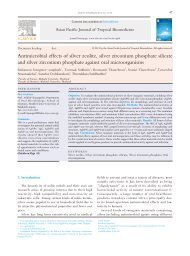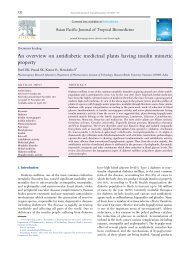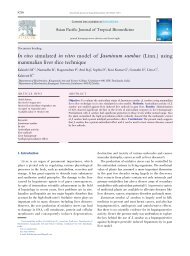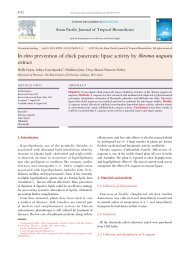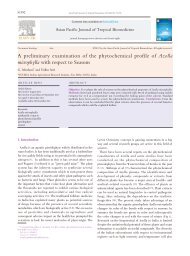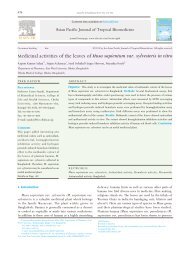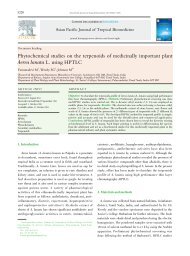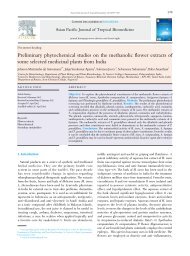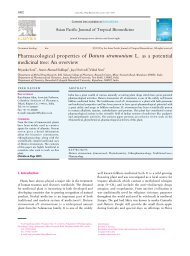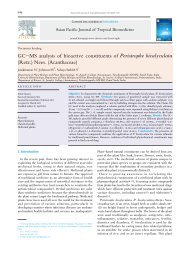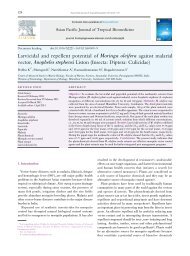Antifungal activity of traditional medicinal plants from Tamil - Apjtb.com
Antifungal activity of traditional medicinal plants from Tamil - Apjtb.com
Antifungal activity of traditional medicinal plants from Tamil - Apjtb.com
You also want an ePaper? Increase the reach of your titles
YUMPU automatically turns print PDFs into web optimized ePapers that Google loves.
Duraipandiyan V and Ignacimuthu S/Asian Pacific Journal <strong>of</strong> Tropical Biomedicine (2011)S204-S215 S215<br />
[71] Sangeetha S, Marimuthu P, Sarada DVL, Ramasamy K. Isolation<br />
<strong>of</strong> antimicrobial <strong>com</strong>pound <strong>from</strong> Sphaeranthus indicus against<br />
human pathogens. Int J Biotech Biochem 2010; 6(4): 569-577.<br />
[72] Duraipandiyan V, Kannan P, Ignacimuthu S. Antimicrobial<br />
<strong>activity</strong> <strong>of</strong> Sphaeranthus indicus L. Ethnobot Leaflets 2009; 13:<br />
320-325.<br />
[73] Duraipandiyan V, Ignacimuthu S, Valanarasu M. Antibacterial<br />
and antifungal <strong>activity</strong> <strong>of</strong> Syzygium lineare Wall. Int J Integrat<br />
Biol 2008; 159: 1- 4.<br />
[74] Slowing K, Carretero E, Villar A. Anti-inflammatory <strong>activity</strong> <strong>of</strong><br />
leaf extracts <strong>of</strong> Eugenia jambos in rats. J Ethnopharmacol 1994;<br />
43: 9-11.<br />
[75] Krishnamoorthy P, Vaithinathan S, Bhuvaneswari A. Protective<br />
effect <strong>of</strong> Syzygium cuminii (Linn.) Skeels seed extract on lipid<br />
peroxidation in alloxan induced diabetic rats. Nat Prod Rad<br />
2006; 5: 103-107.<br />
[76] Warrier PK, Nambiar VPK, Ramankutty C. Indian <strong>medicinal</strong><br />
<strong>plants</strong>. vol. 5. Hyderabad, India: Orient Longman Ltd.; 1996, p.<br />
225-228.<br />
[77] Mathew S, Kuttan G. Anti-oxidant <strong>activity</strong> <strong>of</strong> Tinospora cordifolia<br />
and its usefulness in the amelioration <strong>of</strong> cyclophosphamide<br />
induced toxicity. J Exp Clin Cancer Res 1997; 16: 407-411.<br />
[78] Perumal Samy R, Ignacimuthu S. Screening <strong>of</strong> 34 Indian<br />
<strong>medicinal</strong> <strong>plants</strong> for antibacterial properties. J Ethnopharmacol<br />
1998; 62: 173-178.<br />
[79] Orwa JA, Jondiko IJO, Minja RJA, Bekunda M. The use <strong>of</strong><br />
Toddalia asiatica (L) Lam. (Rutaceae) in <strong>traditional</strong> medicine<br />
practice in East Africa. J Ethnopharmacol 2008; 115(2): 257-262.<br />
[80] Beentje H. Kenya trees, Shrubs and Lianas. Nairobi, Kenya:<br />
National Museums <strong>of</strong> Kenya 1994, p. 564-570.<br />
[81] Duraipandiyan V, Ignacimuthu S. Antibacterial and antifungal<br />
<strong>activity</strong> <strong>of</strong> flindersine isolated <strong>from</strong> the <strong>traditional</strong> <strong>medicinal</strong><br />
plant, Toddalia asiatica (L.) Lam. J Ethnopharmacol 2009; 123:<br />
494-498.<br />
[82] Rajakaruna N, Harris CS, Towers GHN. Antimicrobial <strong>activity</strong> <strong>of</strong><br />
<strong>plants</strong> collected <strong>from</strong> serpentine outcrops in Sri Lanka. Pharm<br />
Biol 2002; 40: 235-244.<br />
[83] Sharma ML, Raina RM, Khanna RK, Sharma OS, Singh A.<br />
Essential oil <strong>from</strong> the leaves <strong>of</strong> Atalantia monophylla (Correa).<br />
Perfum Kosmet 1992; 73: 336-337.<br />
[84] Garcia VMN, Gonzalez A, Fuentes M, Aviles M, Rios MY, Zepeda<br />
G, Rojas MG. <strong>Antifungal</strong> activities <strong>of</strong> nine <strong>traditional</strong> Mexican<br />
<strong>medicinal</strong> <strong>plants</strong>. J Ethnopharmacol 2003; 87: 85-88.<br />
[85] Moulin-Traffort J, Giordani R, Regli P. <strong>Antifungal</strong> action <strong>of</strong> latex<br />
saps <strong>from</strong> Lactuca sativa and Asclepias curassavica. Mycoses 1990;<br />
33: 383-392.<br />
[86] Al-Fatimi M, Wurster M, Schroder G, Lindequist U. Antioxidant,<br />
antimicrobial and cytotoxic activities <strong>of</strong> selected <strong>medicinal</strong><br />
<strong>plants</strong> <strong>from</strong> Yemen. J Ethnopharmacol 2007; 111: 657-666.<br />
[87] Rajan S, Baburaj DS, Sethuraman M, Parimala S. Stem and stem<br />
bark used <strong>medicinal</strong>ly by the tribals Irulas and Paniyas <strong>of</strong> Nilgiri<br />
Distric, <strong>Tamil</strong> Nadu. Ethnobotany 2001; 6: 19-24.<br />
[88] Prashanth Kumar V, Chauhan NS, Padh H, Rajani M. Search for<br />
antibacterial antifungal agents <strong>from</strong> selected Indian <strong>medicinal</strong><br />
<strong>plants</strong>. J Ethnopharmacol 2006; 107: 182-188.<br />
[89] Phongpaichit S, Pujenjob N, Rukachaisirkul V, Ongsakul M.<br />
<strong>Antifungal</strong> <strong>activity</strong> <strong>from</strong> leaf extracts <strong>of</strong> Cassia alata L., Cassia<br />
fistula L. and Cassia tora L. Songklankarin J Sci Tech 2004; 26:<br />
741-748.<br />
[90] Somchit MN, Reezal I, Nur IE, Mutalib AR. In vitro antimicrobial<br />
<strong>activity</strong> <strong>of</strong> ethanol and water extracts <strong>of</strong> Cassia alata. J<br />
Ethnopharmacol 2003; 84: 1-4.<br />
[91] Ibrahim D, Osman H. Antimicrobial <strong>activity</strong> <strong>of</strong> Cassia alata <strong>from</strong><br />
Malaysia. J Ethnopharmacol 1995; 45: 151-156.<br />
[92] Khan MR, Kihara M, Omoloso AD. Antimicrobial <strong>activity</strong> <strong>of</strong><br />
Cassia alata. Fitoterapia 2001; 75: 561-564.<br />
[93] Mathew S, Abraham TM. Studies on the antioxidant activities <strong>of</strong><br />
cinnamon (Cinnamomum verum) bark extracts, through various<br />
in vitro models. Food Chem 2006; 94: 520-528.<br />
[94] Liao BC, Hsieh CW, Liu YC, Tzeng TT, Sun YW, Wung BS.<br />
Cinnamaldehyde inhibits the tumor necrosis factor-α-induced<br />
expression <strong>of</strong> cell adhesion molecules in endothelial cells by<br />
suppressing NF-κB activation: Effects upon IκB and Nrf2.<br />
Toxicol Appl Pharmacol 2008; 229(2): 161-171.<br />
[95] Goswami A, Rahman A. Antiviral <strong>activity</strong> <strong>of</strong> (E)-cinnamaldehyde<br />
revisited with nanoscience tools. Nature Procedings 2010; [Online]<br />
Available form: http://hdl.handle.net/10101/npre.2010.5043.1.<br />
[96] Shaughnessy DT, Setzer RW, DeMarini DM. The antimutagenic<br />
effect <strong>of</strong> vanillin and cinnamaldehyde on spontaneous mutation<br />
in Salmonella TA 104 is due to a reduction in mutations at GC but<br />
not AT sites. Mutat Res 2001; 480-481: 55-69.<br />
[97] Singh HB, Srivastava M, Singh AB, Srivastava AK. Cinnamon bark<br />
oil, a potent fungi toxicant against fungi causing respiratory tract<br />
mycoses. Allergy 1995; 50: 995-999.<br />
[98] Jayaweera DM. Medicinal <strong>plants</strong> used in Ceylon. Colombo:<br />
National Science Council <strong>of</strong> Sri Lanka; 1982, p. 1-5.<br />
[99] Singh SK, Prasad AK, Olsen CE, Jha A, Jain SC, Parmar VS, et al.<br />
Neolignans and alkaloids <strong>from</strong> Piper argyrophyllum. Phytochem<br />
1996; 43: 1355-1360.<br />
[100] Rang DD, Dung NX. Chemical constituents <strong>of</strong> Plumbago<br />
zeylanica Linn. Tap Chi Hoa Hoc 1996; 34: 67-70.<br />
[101] Prashanth D, Asha MK, Amit A. Antibacterial <strong>activity</strong> <strong>of</strong> Punica<br />
granatum. Fitoterapia 2001; 72: 171-173.<br />
[102] Melendez PA, Capriles VA. Antibacterial properties <strong>of</strong> tropical<br />
<strong>plants</strong> <strong>from</strong> Puerto Rico. Phytomedicine 2006; 13: 272-276.<br />
[103] Maurya R, Handa SS. Tinocordifolin, a sesquiterpene <strong>from</strong><br />
Tinospora cordifolia. Phytochem 1998; 1343-1345.<br />
[104] Maurya R, Dhar KL, Handa SS. A sesquiterpene glucoside <strong>from</strong><br />
Tinospora cordifolia. Phytochem 1997; 44: 749-750.<br />
[105] Gangan VD, Pradhan P, Sipahimalani AT, Banerji A.<br />
Norditerpene furan glycosides <strong>from</strong> Tinospora cordifolia.<br />
Phytochem 1995; 39: 1139-1142.<br />
[106] Maurya R, Wazir V, Tyagi A, Kapil RS. Clerodane diterpenoids<br />
<strong>from</strong> Tinospora cordifolia. Phytochem 1995; 38: 659-661.<br />
[107] Wazir V, Maurya R, Kapil RS. Cordioside, a clerodane furano<br />
diterpene glucoside <strong>from</strong> Tinospora cordifolia. Phytochem 1995;<br />
38: 447- 449.<br />
[108] Saxena VK, Sharma RN. Antimicrobial <strong>activity</strong> <strong>of</strong> the essential<br />
oil <strong>of</strong> Toddalia Asiatica. Fittoterapia 1999; 70: 64-66.<br />
[109] Jeevan Ram A, Bhakshu L M, Venkata Raju RR. In vitro<br />
antimicrobial <strong>activity</strong> <strong>of</strong> certain <strong>medicinal</strong> <strong>plants</strong> <strong>from</strong> Eastern<br />
Ghats, India, used for skin diseases. J Ethnopharmacol 2004; 90:<br />
353-357.<br />
[110] Liu XT, Shi Y, Liang JY, Min ZD. Antibacterial ent-rosane and<br />
ent-kaurane diterpenoids <strong>from</strong> Sagittaria trifolia var. sinensis.<br />
Chin J Nat Med 2009; 7(6): 341-345.<br />
[111] Yuan WH, Yi YH, Xue M, Zhang HW, La MP. Two antifungal<br />
active triterpene glycosides <strong>from</strong> sea cucumber Holothuria<br />
(Microthele) axiloga. Chin J Nat Med 2008; 6(2): 105-108.<br />
[112] Muschietti L, Derita M, Sulsen V, Munoz JD, Ferraro G, Zacchino<br />
S, et al. In vitro antifungal assay <strong>of</strong> <strong>traditional</strong> Argentine<br />
<strong>medicinal</strong> <strong>plants</strong>. J Ethnopharmacol 2005; 102: 233-238.



